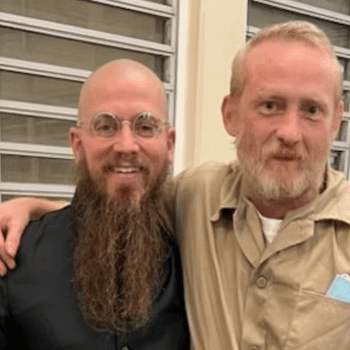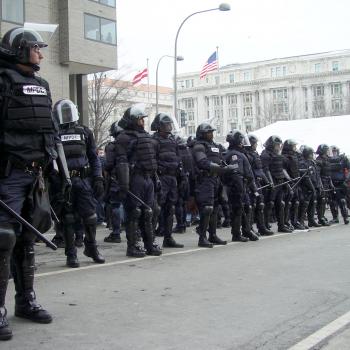 This week I’ve been reading Terry Hershey’s book Sanctuary as part of our Patheos book club roundtable. It’s about how to create sacred space, or sanctuary, in our lives. Hershey defines a sanctuary as “a place where we feel grounded, unhurried, and renewed” (xi). One of the reasons that so many people feel anxious in our culture today is because our world is so saturated with useful space that there isn’t any room for sacred space. Often our way of coping with our lack of sacred space is to spin our wheels and procrastinate in useful space. What we need to do is detach ourselves at least once a day from useful space and remove ourselves to a sacred space where there is no agenda other than to be present to the God who is love.
This week I’ve been reading Terry Hershey’s book Sanctuary as part of our Patheos book club roundtable. It’s about how to create sacred space, or sanctuary, in our lives. Hershey defines a sanctuary as “a place where we feel grounded, unhurried, and renewed” (xi). One of the reasons that so many people feel anxious in our culture today is because our world is so saturated with useful space that there isn’t any room for sacred space. Often our way of coping with our lack of sacred space is to spin our wheels and procrastinate in useful space. What we need to do is detach ourselves at least once a day from useful space and remove ourselves to a sacred space where there is no agenda other than to be present to the God who is love.
Protestant Christianity has a lot of trouble understanding the sacred. We tend to be very pragmatic, rational people. Our weekly worship service is focused on the sermon. It’s basically a message that’s supposed to offer practical tools for living a clean and productive life with enough praise songs and other rituals surrounding it to make it feel sufficiently proper. One thing I can’t get over is how many Protestant sanctuaries uses the same pastel blue carpet that you find in cheap motel hallways. In many churches, the sanctuary really shouldn’t be called a sanctuary, but “the meeting room” or perhaps even “the multipurpose room.”
The Catholics actually get the sacred. I’ve been going to Catholic weekday masses somewhat regularly for the past several years. One thing that struck me is the way that they kneel every time they pass in front of the altar. When they enter the sanctuary, they kneel. And whenever the priest has to walk in front of the altar as part of the mass, he bows. When there’s no mass happening and people are sitting in the room to pray, they still kneel toward the altar when they get up to leave.
In my last congregation, I felt convicted about this a couple of years ago. I would often pass through the sanctuary during the week to get from my office to the water fountain, and I just walked through it like it was any other room. So I decided to start kneeling and crossing myself every time I passed in front of the altar. The other thing I started to do was to use the sanctuary as a full-body prayer space during the week. I had learned of the penitential practice of crawling on your knees to the altar while saying the words of the Jesus prayer: “Lord Jesus Christ, son of God, have mercy on me, a sinner.” So during the season of Lent, the youth pastor and I would perform this ritual together on a daily basis. We would crawl up to the altar and then bury our faces in the carpet at the front for a few moments in silence before pouring out whatever prayers were on our hearts.
Even pastel blue carpet can become sacred space when you bury your face in it on a regular basis. That’s one of the main points of Hershey’s book. Sanctuary can happen anywhere, even in a church sanctuary that doesn’t feel like a sanctuary because you work in the church building all week. Hershey writes, “I used to think I had to go somewhere special–exotic maybe… I guess I assumed that I could enjoy sanctuary only with the change of scenery, as if sanctuary couldn’t happen in my real world” (38).
What Hershey explains is that we can create sacred space in our regular lives. We just need a way of reappropriating our useful space as sacred space. The way Hershey puts it is that we need a “portal” that we pass through in order to leave the stressed out, busy, productive way of viewing our surroundings and “enter” into the sanctuary of God’s loving presence that’s been there all along. He says that this portal can be many things: “the sound of music, chimes, or a rung bell… a specific room you enter… a garden bench… a certain point on your walk” (73). It can also be an action you take to reappropriate your time and space as sacred: “Perhaps you bless the space… You might have a ceremony of some sort… You might light a candle… Your portal might be a mantra, a phrase you repeat for a few moments.”
One of the things I do today to create sanctuary wherever I go is to use my Orthodox prayer beads. Every time I have to walk somewhere on Tulane or Loyola’s campus and my hands aren’t full, I pull out my prayer beads and go through the Jesus prayer. I say it in Greek partly because I’m a nerd and partly because the words are sacred since I wouldn’t ever use them in daily speech for any other reason: “Kurie iesou christe, huie tou theou, eleison me tan hamartalon.” Doing this keeps me present to the presence of God wherever I walk. It is the primary reason I have survived a bumpy first year of campus ministry.
The sanctuary of God’s loving presence is always all around us everywhere. We don’t actually create it; we just “create” our awareness of it. There are many different portals we can use for “entering” this space. You need to find one that fits with the space and time of your life each week. As the Eastern Orthodox theologians say, heaven is actually earth perceived correctly. Likewise, I would say that hell is a life that completely ignores God’s sanctuary. Heaven is always available to us, since God is always reaching out to us in love to help us experience his communion. But he won’t force his sanctuary upon us.
















